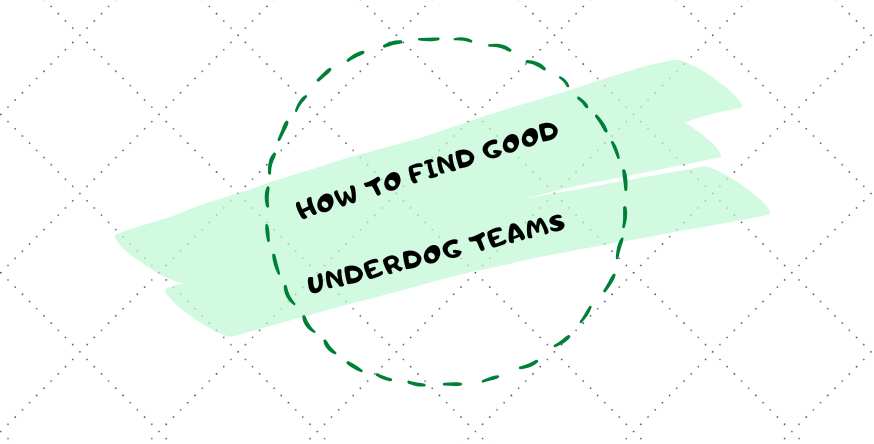Identifying valuable underdog teams can enhance betting strategies by offering opportunities where the odds may not accurately reflect a team’s chances. Success in this area relies on thorough research, an objective analysis of team performance, and attention to relevant trends such as recent form, injuries, or tactical adjustments. Additionally, understanding how betting markets react to public sentiment can reveal instances where an underdog may be undervalued.

By systematically evaluating these factors, bettors can make informed decisions and potentially identify underdogs with a higher probability of outperforming expectations. It is important to approach this process methodically and rely on data-driven insights rather than assumptions or intuition.
Start With Thorough Team Research
Before placing bets on underdog teams, thorough research is essential to uncover those with real potential. Start by analyzing recent performance trends, including game results and consistency against stronger opponents—look for signs of steady improvement or resilience.
Check out head-to-head matchups, as some underdogs have historically performed well against specific rivals. Keep a close eye on injury reports, suspensions, and roster changes, since missing key players can dramatically affect a team’s chances.
Additionally, review historical outcomes in similar scenarios to separate genuine value from mere perception. Grounding your bets in solid data rather than hype will greatly enhance your ability to identify underdogs worth backing.
Identifying Key Underdog Traits
After compiling comprehensive data on team performance and situational factors, it’s important to identify traits that can increase the likelihood of an underdog achieving an upset. Patterns such as recent improvements in performance or modest winning streaks may indicate potential that isn’t reflected in the odds.
Analyzing head-to-head matchups is also relevant, as some underdogs have a history of performing comparatively well against specific opponents. Additionally, injuries affecting key players on favored teams can shift competitive dynamics, creating potential value on the underdog.
It’s also useful to assess whether an underdog’s strengths, such as a strong running game, align with weaknesses in the favored team’s defense. Other considerations include home-field advantage and the significance of the match, as these can influence team motivation and performance.
Analyzing Line Movements and Market Trends
While statistics and team analysis play a significant role in sports betting, tracking line movements and market trends also provide valuable information, especially when evaluating underdog teams.
Observing line movements can reveal where most wagers are being placed and highlight instances when odds are adjusted due to professional bettor influence.
Comparing the opening and closing lines is useful for understanding how both public sentiment and expert analysis impact odds throughout the market cycle.
In particular, if a line shifts in favor of the underdog despite widespread public backing of the favorite, this may indicate that informed bettors perceive value in the underdog.
When putting your research into action, finding a trustworthy platform is just as important as your analysis. If you are looking for reliable sportsbooks to place your bets, be sure to check out the top-rated sportsbooks reviews by MegaBetList for trusted recommendations. Incorporating line movement analysis into a broader research approach can support more informed and objective wagering decisions.
Spotting Overvalued Favorites
Identifying overvalued favorites in the betting market involves a careful evaluation of market dynamics and objective performance factors. An overvalued favorite typically has odds that don’t accurately reflect actual team or player strength, often influenced by public perception or recent media attention.
It’s important to assess whether a favorite’s recent form, injury status, or schedule challenges—such as extensive travel—have been adequately factored into the odds.
Reviewing historical head-to-head results can reveal if the underdog has performed competitively in past meetings, which may indicate that the favorite isn’t as dominant as the odds suggest.
Monitoring betting patterns can also be informative; significant betting activity on the favorite may result in line inflation, potentially creating value on the underdog side.
Consistently applying these analytical methods can assist in identifying situations where the favorite may be overpriced.
Effective Bankroll Management for Underdog Bets
Effective bankroll management is an important component of betting on underdog teams. This approach involves allocating a small percentage of your total bankroll to each wager in order to limit potential losses and sustain long-term participation.
A general guideline is to restrict individual underdog bets to no more than 5% of your overall bankroll, while higher-risk bets may warrant using only 2-3%. Establishing predetermined betting limits and adhering to them helps minimize the risk of significant losses.
It’s also advisable to review your results regularly and adjust your strategy based on performance and changes in available information. Consistent bankroll management ensures that funds remain available for future opportunities and reduces the likelihood of rapid depletion due to unfavorable outcomes.
Conclusion
By diving into team research, spotting key underdog traits, and tracking line movements, you’ll uncover hidden value others might miss. Stay sharp on market trends and always question if favorites are truly worth their hype. Remember, managing your bankroll smartly lets you play the long game and capitalize when your research pays off. Trust your analysis, embrace the underdog mindset, and you’ll put yourself in a strong position to beat the odds.



